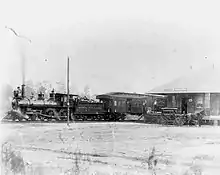Georgia Florida and Alabama Railroad
The Georgia, Florida and Alabama Railroad[1][note 1] (the G.F. & A.), known as the Sumatra Leaf Route, and colloquially as the Gopher, Frog & Alligator[2][3] was a 180 miles (290 km)-long railroad from Richland, Georgia to Carrabelle, Florida.[4] It was founded in 1895 as a logging railroad, the Georgia Pine Railway.
 A Georgia, Florida and Alabama Railroad train at Carrabelle | |
| Overview | |
|---|---|
| Headquarters | Arlington, Georgia |
| Reporting mark | GF&A |
| Locale | Southwest Georgia, Northwest Florida |
| Dates of operation | 1895–1944 |
| Technical | |
| Track gauge | 1,435 mm (4 ft 8 1⁄2 in) (standard gauge) |
| Length | 180 miles (290 km) |
The northern and southern ends of the railroad have been abandoned, but the section from Cuthbert, Georgia, to Tallahassee, Florida, remains in use by various railroads.
History

Hannibal Kimball promoted the Bainbridge, Cuthbert and Columbus Railroad to run north-to-south through southwest Georgia in 1869. Although work began on construction in 1870, it was never completed, and in 1872 the project was abandoned amidst financial problems and bond endorsement issues that stirred allegations of impropriety against Kimball. During the 1880s, attempts were made to revive the railroad, with some activity taking place in the middle of that decade, but this too came to nothing.[5]
Finally, in 1895 local entrepreneur J. D. Williams laid rails on part of the route creating the Georgia Pine Railroad connecting Bainbridge to Arlington. By 1898, the railroad was renamed the Georgia Florida and Alabama Railroad[5] and by 1901, it had been extended north to Richland.[6] In 1902, the G.F. & A. completed the section from Tallahassee to Bainbridge.[7]
The G.F.& A. was leased to the Seaboard Air Line Railway in 1927. The Seaboard went into receivership at the end of 1930,[8] and the lease was revoked in 1931. The Seaboard was reformed after receiving government loans, and it agreed to operate, but not lease the G.F. & A. In 1944, the court that was overseeing the Seaboard's receivership authorized the company to purchase 90% of the G.F. & A.'s bonds.[9]
Seaboard became part of CSX Transportation in 1980. In 1983, the former G.F. & A. line was sold off to the South Carolina Central Railroad, and in 1989 it became part of the Georgia Southwestern Railroad.[10] In 1997, the portion of the G.F. & A. route from Richland south to Cuthbert was abandoned,[11] and in 2002 the Georgia Department of Transportation acquired the remaining Cuthbert to Bainbridge section. The Georgia Southwestern remains the operator of the line.[12][13]
Route
The northern terminus of the line was at Richland, where it met the Savannah, Americus and Montgomery Railway and the Columbus Southern Railway. It ran almost due south through Cuthbert and Edison to reach Arlington, where it crossed the Central of Georgia Railway. It continued through Colquitt and Bainbridge before crossing the Flint river and entering Florida. It continued through Sopchoppy and Tallahassee and on to its southern terminus in Carrabelle on the Florida Gulf Coast.[6]
Today
The Cuthbert-Bainbridge segment is now owned by the Georgia Department of Transportation and operated by the Georgia Southwestern Railroad.
The segment from Bainbridge to Attapulgus, Georgia, is owned by CSX.
The Attapulgus-Tallahassee segment is owned by the Florida Gulf & Atlantic Railroad.
A 2.4-mile part of the abandoned Tallahassee-Carrabelle segment of the GF&A is now the Tallahassee-Georgia Florida and Alabama (GF&A) Trail in the Apalachicola National Forest.[14][15][16] Research work on the rail-to-trail project was done by Genesis Group.[17]
Notes
- Sources differ on the use of Railroad vs Railway in the official name of the company.
References
- "An Act To authorize the Georgia, Florida and Alabama Railway" (PDF). 20 June 1906.
- "Historical & Educational".
- Hallberg, M.C. (21 December 2009). RAILROADS IN NORTH AMERICA Some Historical Facts and An Introduction to an Electronic Database of North American Railroads and Their Evolution.
- Prince, Richard E. (2000). Seaboard Air Line Railway: Steam Boats, Locomotives, and History. Indiana University Press. p. 97. ISBN 0-253-33695-3.
- Florida Public Service Commission (1898). Report. p. 10.
- Caldwell, Wilber W. (2001). The Courthouse and the Depot: The Architecture of Hope in an Age of Despair : a Narrative Guide to Railroad Expansion and Its Impact on Public Architecture in Georgia, 1833-1910. Mercer University Press. pp. 298, 507–513. ISBN 978-0-86554-748-3.
- Florida Railroad and Public Utilities Commission (1902). Report. pp. 6, 36.
- Prince, Richard E. (2000) [1966]. Seaboard Air Line Railway: Steam Boats, Locomotives, and History. Indiana University Press. ISBN 978-0-253-33695-8.
- United States. Congress. House. Committee on the Judiciary. Special Subcommittee on Bankruptcy and Reorganization (1947). Railroad Reorganization: Hearings Before Special Committee on Bankruptcy and Reorganization, Eightieth Congress, First Session, on H.R. 3237. U.S. Government Printing Office. pp. 242–.
- Lewis, Edward A. (1996). American Shortline Railway Guide. Kalmbach Publishing, Co. p. 183. ISBN 978-0-89024-290-2.
- Thornhill, Tommy (2002). "Pig Trails of Southwest Georgia: Part 2". Lines South. White River Productions. 19 (1): 22–29.
- "STB Finance Docket No. 34057". 18 January 2002. Retrieved 13 September 2010.
- "STB Finance Docket No. 34057". 30 April 2002. Retrieved 13 September 2010.
- "GF&A Trail". USDA Forest Service. Retrieved 19 October 2019.
- "Apalachicola National Forest - History & Culture".
- "Georgia Florida & Alabama Trail (GF&A Trail) | Florida Trails | TrailLink". www.traillink.com.
- "Genesis". Genesis - Engineering, Planning, Landscape Architecture, Survey, and GIS.
External links
- "Georgia, Florida and Alabama Railway in Seaboard Air Line Railway: Steam Boats, Locomotives, and History by Richard E. Prince, 1966; reprinted 2000.
- "The Story of the Georgia Florida and Alabama RR" by Donald R. Hensley, Jr., at Taplines.net - includes a good map of the GF&A prior to its acquisition by the Seaboard in 1927.